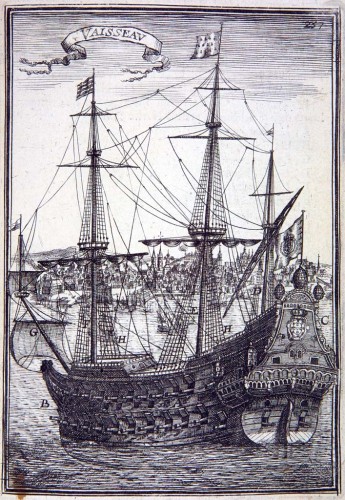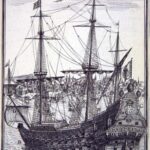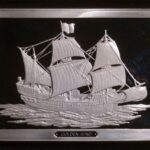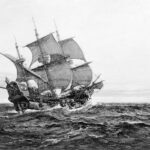Galleon
Ship
Age of Discovery
Quick Facts:
The galleon developed in the early 16th century from ships such as the caravel and the carrack.
The galleon developed in the early 16th century from ships such as the caravel and the carrack. The galleon design varied between regions. The shipwright varied hull and sail configuration based on the ship’s homeport, its destination, and the cargo it carried. Galleons were also fitted as warships and tended to have more ribs and bracing to withstand gunfire.
The caravel was like sailing a bathtub, so the hull of the galleon was elongated for stability, and the forecastle was lowered, creating less wind resistance that helped increase the speed of the ship and its ability to maneuver. The galleon usually carried three masts, and the fore and main masts were square rigged, with the mizzenmast being lateen rigged. Below the bowsprit was a “beak” used for ramming. The forecastle was lower than the aft castle with a flat stern for speed.
Galleons were generally smaller than the Portuguese carrack, which weighed an average of 500 tons. Galleons were often cheaper to build than the more traditional caravel or carrack. Many European countries used galleons as merchant or supply ships in peace, and could quickly convert them to war ships in times of trouble. The Spanish used the vast amount of cargo space in the galleon to carry the New World treasure across the Atlantic. The galleon could withstand the rigors of ocean voyages.
- “Vaisseau,” Description de L’Univers, 1683, From The Library at The Mariners’ Museum, G114.M25 rare.
- “A) Galion, B) Fregate, C) Caraque, D) Flute ou Pinque, E) Est un Beulot ou Bâtiment,” Description de L’Univers, 1683, From The Library at The Mariners’ Museum, G114.M25 rare.
- Decorative ingot of the “Golden Hind”, Part of “The Great Sailing Ships of History” series, 1974, The Franklin Mint, The Mariners’ Museum.
- Golden Hind, 1927, by Montague Dawson, The Mariners’ Museum.





